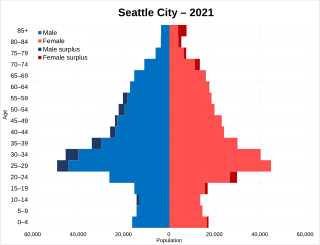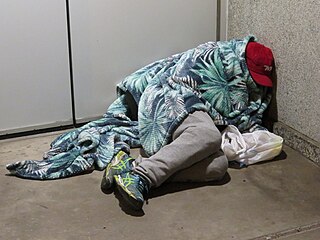
Lennox is a census-designated place (CDP) in the South Bay region of Los Angeles County, California, United States. The population was 22,753 at the 2010 census, down from 22,950 at the 2000 census.

A skid row, also called skid road, is an impoverished area, typically urban, in English-speaking North America whose inhabitants are mostly poor people "on the skids". This specifically refers to people who are poor or homeless, considered disreputable, downtrodden or forgotten by society. A skid row may be anything from an impoverished urban district to a red-light district to a gathering area for people experiencing homelessness or drug addiction. In general, skid row areas are inhabited or frequented by impoverished individuals and also people who are addicted to drugs. Urban areas considered skid rows are marked by high vagrancy, dilapidated buildings, and drug dens, as well as other features of urban blight. Used figuratively, the phrase may indicate the state of a poor person's life.

In the United States, the number of homeless people on a given night in January 2023 was more than 650,000 according to the Department of Housing and Urban Development. Homelessness has increased in recent years, in large part due to an increasingly severe housing shortage and rising home prices in the United States.

The Seattle metropolitan area is an urban conglomeration in the U.S. state of Washington that comprises Seattle, its surrounding satellites and suburbs. The United States Census Bureau defines the Seattle–Tacoma–Bellevue, WA metropolitan statistical area as the three most populous counties in the state: King, Pierce, and Snohomish. Seattle has the 15th largest metropolitan statistical area (MSA) in the United States with a population of 4,018,762 as of the 2020 census, over half of Washington's total population.

A tent city is a temporary housing facility made using tents or other temporary structures.

The population of the city of Seattle, in the U.S. state of Washington, was 737,015 in the 2020 United States census. Only about a fifth of the households include minor children, and more people live alone here than any other U.S. city besides San Francisco. Seattle's population is mostly white, with a relatively large minority of Asians. It has the largest African American population in the area and a Latino population that is growing quickly. About half the population are Christians and about a third are unaffiliated.

Affordable housing is housing which is deemed affordable to those with a household income at or below the median as rated by the national government or a local government by a recognized housing affordability index. Most of the literature on affordable housing refers to mortgages and a number of forms that exist along a continuum – from emergency homeless shelters, to transitional housing, to non-market rental, to formal and informal rental, indigenous housing, and ending with affordable home ownership.

Homelessness or houselessness – also known as a state of being unhoused or unsheltered – is the condition of lacking stable, safe, and functional housing. The general category includes disparate situations, such as living on the streets, moving between temporary accommodation such as family or friends, living in boarding houses with no security of tenure, and people who leave their domiciles because of civil conflict and are refugees within their country.
Perhaps the most accurate and current data on homelessness in the United States is reported annually by the Department of Housing and Urban Development (HUD) in the Annual Homeless Assessment Report to Congress (AHAR). The AHAR report relies on data from two sources: single-night, point-in-time counts of both sheltered and unsheltered homeless populations reported on the Continuum of Care applications to HUD; and counts of the sheltered homeless population over a full year provided by a sample of communities based on data in their local Homeless Management Information Systems (HMIS).

The Jungle, officially known as the East Duwamish Greenbelt, is a greenbelt on the western slope of Beacon Hill in Seattle, Washington that is known for its homeless encampments and crime. The Jungle consists of 150 acres (61 ha) underneath and along an elevated section of Interstate 5 between South Dearborn Street and South Lucile Street. An assessment counted 201 tents and estimate of more than 400 people in the area prior to a shooting on January 26, 2016, that increased scrutiny and a sweep of the greenspace. The area continues to be used by the homeless as of 2024.

The San Francisco Bay Area comprises nine northern California counties and contains five of the ten most expensive counties in the United States. Strong economic growth has created hundreds of thousands of new jobs, but coupled with severe restrictions on building new housing units, it has resulted in an extreme housing shortage which has driven rents to extremely high levels. The Sacramento Bee notes that large cities like San Francisco and Los Angeles both attribute their recent increases in homeless people to the housing shortage, with the result that homelessness in California overall has increased by 15% from 2015 to 2017. In September 2019, the Council of Economic Advisers released a report in which they stated that deregulation of the housing markets would reduce homelessness in some of the most constrained markets by estimates of 54% in San Francisco, 40 percent in Los Angeles, and 38 percent in San Diego, because rents would fall by 55 percent, 41 percent, and 39 percent respectively. In San Francisco, a minimum wage worker would have to work approximately 4.7 full-time jobs to be able to spend less than 30% of their income on renting a two-bedroom apartment.

Homelessness in the United States has occurred to varying degrees across the country. The total number of homeless people in the United States fluctuates and constantly changes hence a comprehensive figure encompassing the entire nation is not issued since counts from independent shelter providers and statistics managed by the United States Department of Housing and Urban Development vary greatly. Federal HUD counts hover annually at around 500,000 people. Point-in-time counts are also vague measures of homeless populations and are not a precise and definitive indicator for the total number of cases, which may differ in both directions up or down. The most recent figure for the year 2019 that was given was at 567,715 individuals across the country that have experienced homelessness at a point in time during this period.

Homelessness is a growing problem in Colorado and is considered the most important social determinants of health. Homelessness is very difficult for many Coloradoans to escape due to the continuous increase in costs for housing in Colorado, along with mental health treatments and other factors. When people are forced to live without stable shelter, they are then exposed to a number of risk factors that affect physical and mental health. Although it is difficult to pin point any one cause of homelessness, there is a complicated combination of societal and individual causes.

The United States Department of Housing and Urban Development estimated that more than 181,399 people were experiencing homelessness in California in January 2023. This represents more than 27% of the homeless population of the United States even though California has slightly less than 12% of the country's total population, and is one of the highest per capita rates in the nation, with 0.46% of residents being homeless. More than two-thirds of homeless people in California are unsheltered, which is the highest percentage of any state in the United States. During "A single night in Janurary 2023", 49% of the unsheltered homeless people in the United States lived in California: about 123,423 people, which is eight times as many as the state with the second highest total. Even those who are sheltered are so insecurely, with 90% of homeless adults in California reporting that they spent at least one night unsheltered in the past six months.

In 2016, a report from the Department of Housing and Urban Development (HUD) revealed that the U.S. state of Oregon had an estimated homeless population of 13,238 with about 60.5% of these people still unsheltered. In 2017, these numbers were even higher. As of January 2017, Oregon has an estimated 13,953 individuals experiencing homelessness. Of this homeless population, 1,083 are family households, 1,251 are veterans, 1,462 are unaccompanied young adults, and 3,387 are individuals experiencing chronic homelessness. As of 2022, 17,959 people total experienced homelessness in Oregon, with 2,157 individuals being youth under 18, 6,671 being female, 10,931 being male, and 131 being transgender. Also among the 17,959 total homeless in 2022, 15,876 were Non-Hispanic/Non-Latino, 2,083 were Hispanic/Latino, 13,960 were white, 1,172 were Black, African American, or African, 101 were Asian or Asian American, 880 were Native American, and those of multiple race were 1,619. Oregon has seen an increase in its total homeless population consistently every year since 2010. In last three years specifically Oregon has seen a 98.5% increase 2021-2022, 22.5% increase 2020-2021, and a 13.1% increase 2019-2020.
The Point-in-Time Count, or PIT Count, is an annual survey of homeless people in the United States conducted by local agencies called Continuums of Care (CoCs) on behalf of the United States Department of Housing and Urban Development (HUD). HUD uses the data from PIT counts to evaluate the effectiveness of local agencies' efforts to address homelessness and to determine funding amounts for them, and also compiles this data into the Annual Homeless Assessment Report, which is provided to Congress. HUD defines the PIT as a "count of sheltered and unsheltered homeless persons carried out on one night in the last 10 calendar days of January or at such other time as required by HUD."

Housing in the United States comes in a variety of forms and tenures. The rate of homeownership in the United States, as measured by the fraction of units that are owner-occupied, was 64% as of 2017. This rate is less than the rates in other large countries such as China (90%), Russia (89%) Mexico (80%), or Brazil (73%).
We Heart Seattle (WHS), formerly We Heart Downtown Seattle and incorporated as I Heart Downtown Seattle, is a volunteer organization responding to trash and homelessness in Seattle. The group organizes volunteer trash cleanups in public parks in which homeless people have established camps, primarily through a public Facebook group and Facebook events.

The U.S. city of Minneapolis featured officially and unofficially designated camp sites in city parks for people experiencing homelessness that operated from June 10, 2020, to January 7, 2021. The emergence of encampments on public property in Minneapolis was the result of pervasive homelessness, mitigations measures related to the COVID-19 pandemic in Minnesota, local unrest after the murder of George Floyd, and local policies that permitted encampments. At its peak in the summer of 2020, there were thousands of people camping at dozens of park sites across the city. Many of the encampment residents came from outside of Minneapolis to live in the parks. By the end of the permit experiment, four people had died in the city's park encampments, including the city's first homicide victim of 2021, who was stabbed to death inside a tent at Minnehaha Park on January 3, 2021.
Mass. and Cass, also known as Methadone Mile or Recovery Road, is an area in Boston, Massachusetts located at and around the intersection of Melnea Cass Boulevard and Massachusetts Avenue. Due to its concentration of neighborhood services providing help, the area around Mass. and Cass has long attracted a large number of people struggling with homelessness and drug addiction, especially after the closure of facilities on Long Island. It has been characterized as "the epicenter of the region's opioid addiction crisis".



















